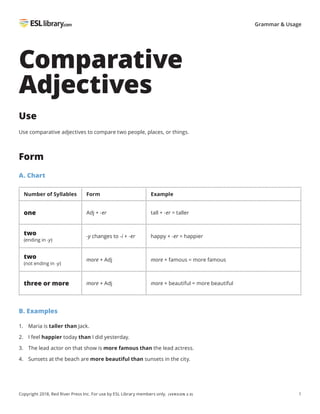103_Comparative-Adjectives_Can.pdf
- 1. 1 Copyright 2018, Red River Press Inc. For use by ESL Library members only. (VERSION 2.0) Grammar & Usage Comparative Adjectives Use Use comparative adjectives to compare two people, places, or things. Form A. Chart Number of Syllables Form Example one Adj + -er tall + -er = taller two (ending in -y) -y changes to -i + -er happy + -er = happier two (not ending in -y) more + Adj more + famous = more famous three or more more + Adj more + beautiful = more beautiful B. Examples 1. Maria is taller than Jack. 2. I feel happier today than I did yesterday. 3. The lead actor on that show is more famous than the lead actress. 4. Sunsets at the beach are more beautiful than sunsets in the city.
- 2. 2 Comparative Adjectives Grammar & Usage Copyright 2018, Red River Press Inc. For use by ESL Library members only. (VERSION 2.0) Spelling Rules for Adding -er A. Chart Rule # Spelling Rule Example 1 If the adjective ends in -e, add -r. ŌĆó nice ’üĪ nicer ŌĆó safe ’üĪ safer ŌĆó large ’üĪ larger 2 If the adjective ends in a consonant-vowel-consonant (CVC) pattern, double the final consonant and add -er. ŌĆó big ’üĪ bigger ŌĆó wet ’üĪ wetter ŌĆó flat ’üĪ flatter 3 If the adjective ends with a consonant + -y, change -y to -i and add -er. ŌĆó easy ’üĪ easier ŌĆó funny ’üĪ funnier ŌĆó pretty ’üĪ prettier 4 For all other adjectives, add -er. ŌĆó tall ’üĪ taller ŌĆó soft ’üĪ softer ŌĆó loud ’üĪ louder B. Examples 1. The hotel room is larger than my bedroom at home. 2. An elephant is bigger than a horse. 3. TodayŌĆÖs test was easier than last weekŌĆÖs. 4. My new pillow is softer than my old one.

